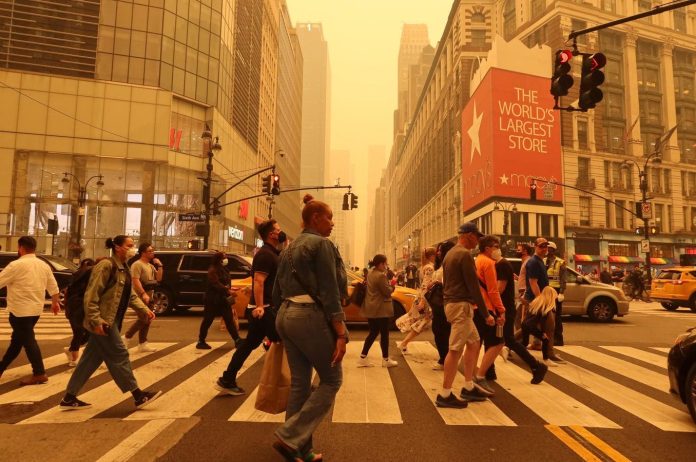NEW YORK, NY – JUNE 7: People cross 34th Street in Herald Square as heavy smoke fills the air on … More
Almost half of Americans are being exposed to unhealthy levels of air pollution, according to a new analysis.
The American Lung Association’s 2025 State of the Air report claims 156 million Americans are living in areas with poor ozone or particulate pollution (often referred to as PM2.5) levels, 25 million more than last year’s report.
The report examines air quality data from 2021 to 2023 and the latest report found 77.2 million people live in counties which have experienced unhealthy spikes in particle pollution.
And it claims more than 125 million people lived in an area with unhealthy ozone pollution levels.
The Californian city of Bakersfield was judged to be the most polluted by short-term and year-round particle pollution, while Los Angeles was named as the most polluted city for ozone pollution.
The study also warns extreme heat and wildfires have contributed to the increase in ozone levels for many parts of the country, including central states from Minnesota to Texas.
The association’s national senior director for policy and report author Katherine Pruitt said air pollution controls based on the Clean Air Act had led to pollution levels coming down for several decades, but over the last 10 years that trend started to reverse in an interview.
Pruitt added ozone levels took a real turn for the worse this year after several years of improvement in many parts of the country and the report highlights the link between ozone and wildfire smoke in an interview.
The report states scientists found a clear link between the fires and the extreme levels of ozone pollution hundreds of miles downwind.
Pruitt said this is in large part why central states were hit hard this year by “unprecedented levels of ozone” despite being far away from the wildfires themselves.
“This report is a credible record of all the successful effort, which has gone into air pollution control,” she added.
“The current air pollution control laws and policies are based on science and based in the law. As the population and economy grew, the air got cleaner.
“However, we are now seeing the reversal of that trend and there is a concern that if we start to roll back protections, we could end up in the situation where we were at the beginning, if not worse.”
Elizabeth Bechard, the public health manager at Moms Clean Air Force said the EPA’s job is to protect communities from air and climate pollution in an email.
Bechard added it is deeply concerning to see the agency trying to roll back so many of the clean air and climate protections meant to help keep people safe.
“As the Los Angelees wildfires underlined in harrowing detail earlier this year, human-caused global warming is increasing the risk and severity of wildfires,” said Bechard.
“We know that wildfires are eroding decades of progress on cleaning up particle pollution in the U.S, making it all the more essential to address the sources of pollution that we can control, like industrial emissions.
“We also know that the extreme temperatures so many communities are experiencing because of global warming make ground-level ozone worse,” she added.
In March, monitoring company IQAir published a global analysis, which found just seven countries, including Australia, Iceland and New Zealand met World Health Organisation annual guidelines around PM2.5 particle pollution in 2024.
IQAir’s air quality science manager, Dr. Christi Chester-Schroeder said air quality in the U.S. is generally better than in many developing countries, but wildfires in particular can still have a large impact closer to home, in an interview.
Dr. Chester-Schroeder said IQAir’s recently global study showed there had been some “major improvements” in terms of PM2.5 pollution in North America last year, which was due to a lack of major wildfires, which had sent levels rising in 2023.
Last month’s study found Los Angeles to be the most polluted major city in the U.S. last year, while Seattle, Washington was deemed to be the cleanest.
“In 2024, there were not any major air quality events that drastically affected really large regions across the country,” said Dr. Chester-Schroeder.
“The PM2.5 levels we saw in 2024 were really more reflective of local air quality issues, not the sweeping wildfires which affected large parts of the country.”




